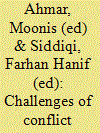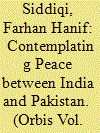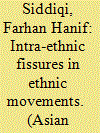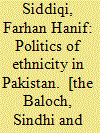|
|
|
Sort Order |
|
|
|
Items / Page
|
|
|
|
|
|
|
| Srl | Item |
| 1 |
ID:
049259


|
|
|
|
|
| Publication |
Karachi, Department of International relations, 2001.
|
| Description |
ii, 199p.
|
|
|
|
|
|
|
|
|
|
|
|
Copies: C:1/I:0,R:0,Q:0
Circulation
| Accession# | Call# | Current Location | Status | Policy | Location |
| 044146 | 303.69/AHM 044146 | Main | On Shelf | General | |
|
|
|
|
| 2 |
ID:
192595


|
|
|
|
|
| Summary/Abstract |
India-Pakistan relations are at an inflection point with India’s dramatic revocation of Kashmir’s autonomy and its desired objective to transform the nature of the Kashmir conflict from a “bilateral” (involving Pakistan) to a “unilateral” status (excluding Pakistan). Pakistan, on the other hand, has embarked on a diplomatic offensive making the case against India’s majoritarian politics in Kashmir as detrimental not only to the Kashmiris but also to the strategic stability between the two rivals. This article reasons that India’s and Pakistan’s dominant zero-sum strategies—premised on winning while ensuring the other’s loss—are least likely to come to fruition. Given the present nature of ties, the way forward is for the two states to engage in a minimalist framework where mutual interests, as opposed to dominant positions, are put forth as a basis for engagement. Second, engagement more than agreement should be the short- to medium-term goal. Finally, any talk during this time on freezing the Kashmir conflict is least likely to bring any long-term dividends for peace and stability between the two regional adversaries.
|
|
|
|
|
|
|
|
|
|
|
|
|
|
|
|
| 3 |
ID:
095457


|
|
|
|
|
| Publication |
2010.
|
| Summary/Abstract |
The article charts the rise of Mohajir identity politics in Pakistan since 1971. Most accounts of Mohajir identity politics have focused mainly on one actor, that is, the Mohajir (now Muttahida) Qaumi Movement and their politics and secondly, have remained silent on intra-ethnic fissures within the Mohajir community. The present article builds on and criticises such accounts for their partiality and presents a more nuanced understanding of politics within the Mohajir community. On the theoretical plane, it criticises modernist and primordialist accounts of ethnicity and nationalism, both of which portray a homogenous picture of ethnic groups as based on unity and shared aims. It is shown that unity and shared aims are at best, a chimera, and that intra-ethnic fissure is as important to understand as is inter-ethnic conflict when it comes to analysing ethnic movements.
|
|
|
|
|
|
|
|
|
|
|
|
|
|
|
|
| 4 |
ID:
114184


|
|
|
|
|
| Publication |
Oxon, Routledge, 2012.
|
| Description |
150p.
|
| Standard Number |
9780415686143
|
|
|
|
|
|
|
|
|
|
|
|
Copies: C:1/I:0,R:0,Q:0
Circulation
| Accession# | Call# | Current Location | Status | Policy | Location |
| 056788 | 305.80095491/SID 056788 | Main | On Shelf | General | |
|
|
|
|
| 5 |
ID:
117033


|
|
|
|
|
| Publication |
2012.
|
| Summary/Abstract |
Balochistan is in the grip of two distinct and mutually exclusive ethnonational and religious movements that straddle important swathes of its rugged and mountainous territory. From Quetta up in the north to the coast of Makran in the south, Balochistan is being shaped by the twin forces of local nationalism and jihadist organizations. Domestically, the issue of Balochistan has remained an Achilles heel for Pakistan's policy makers culminating in five separate insurgencies in the post-colonial era. All such insurgencies had to do with the imperative of a centralizing elite and the recalcitrance of a local elite resisting assimilationist pressures. On the religious front, since 2009 Balochistan has come under increased scrutiny, with the Americans alleging that Quetta and its environs are a safe haven for the Taliban leadership, including Mullah Omar. Coincidentally, Quetta has also seen rising sectarian conflict, and the Shia-Sunni divide in the city continues to assume importance in the War on Terror. In light of the rising tide of Baloch nationalism and jihadist activism, including sectarian killings, the paper puts forth a critically oriented analysis of the twin dynamics of religious activism and ethnic conflict in Balochistan and its attendant ramifications for domestic, regional, and global security.
|
|
|
|
|
|
|
|
|
|
|
|
|
|
|
|
|
|
|
|
|